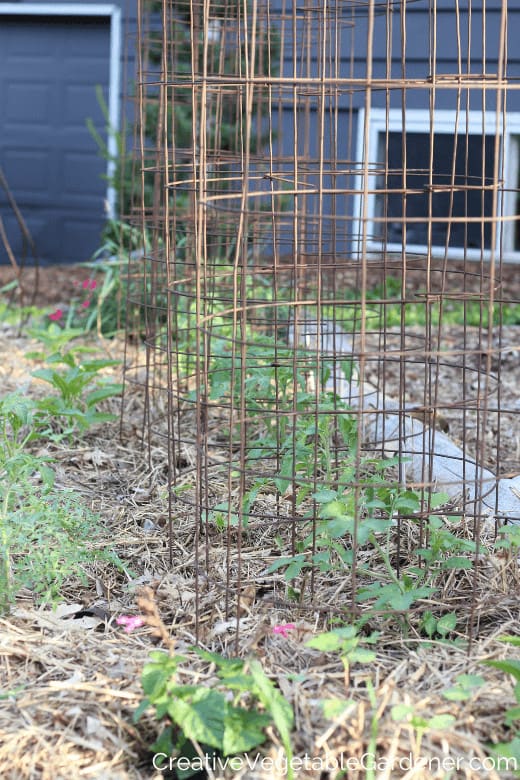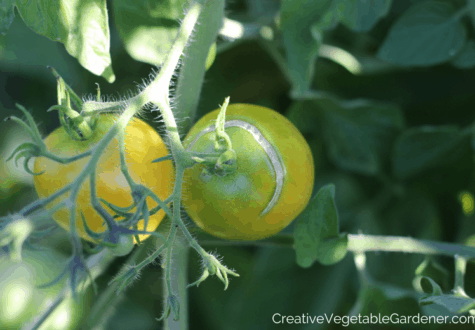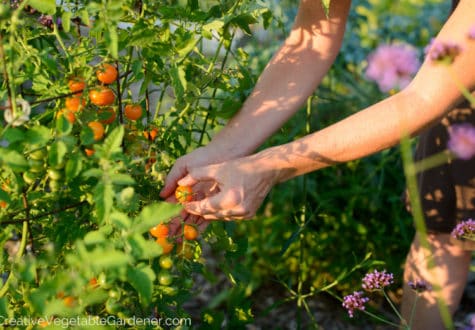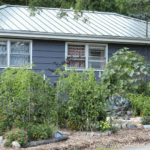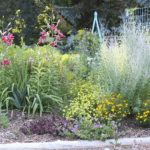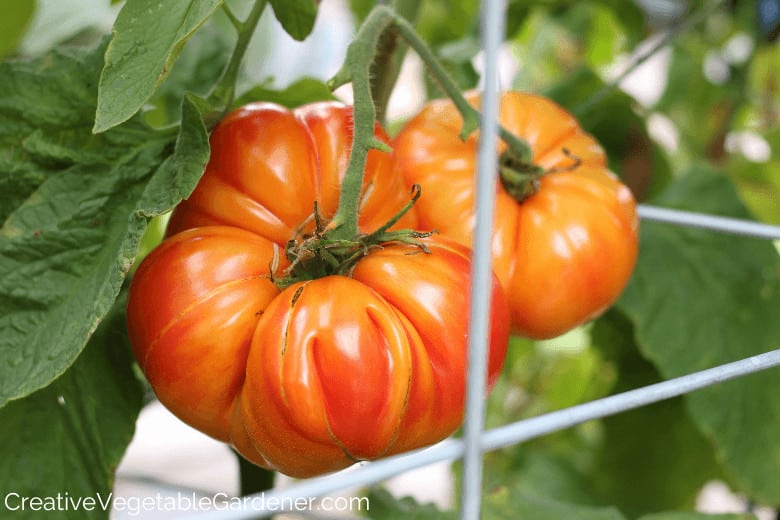 Whether you’re a rural dweller with a huge vegetable garden or an urbanite who practices small space gardening, you’ve probably tried your hand at growing tomatoes. Everyone loves the savory taste of homegrown tomatoes, and growing them can be fun.
Whether you’re a rural dweller with a huge vegetable garden or an urbanite who practices small space gardening, you’ve probably tried your hand at growing tomatoes. Everyone loves the savory taste of homegrown tomatoes, and growing them can be fun.
While growing tomatoes has its rewards, it also has its challenges. Because tomato plants grow rapidly, they need to be caged or the tomato stems can bend or even break, spilling all of that beautiful fruit on the ground.
So what do you do? You’ve probably heard that many gardeners use tomato cages. But you may be unsure of how to buy and use them. In this article, I’ll share some tips on how to use tomato cages to assure that you have plenty of ripe, juicy tomatoes all season.
These are the DIY tomato cages I made for my garden
This post contains affiliate links.
Why Use Tomato Cages
I can’t imagine growing tomatoes without caging them. It would be a disaster! Here are the reasons why I highly recommend learning how to use tomato cages:
Unsupported tomato plants can sprawl onto the ground because their stems become too weak and wobbly to support their large size and heavy fruit.
It’s possible that the stems could even snap, particularly during a hard wind and rain storm. Then you’d lose all of that wonderful fruit that you’d been looking forward to harvesting.
Tomatoes that lie sprawled on the ground are more susceptible to diseases, the bane of all organic gardeners.
Many plant diseases spread through the soil, so read more about ways to prevent tomato disease.
Sprawling tomatoes can rot easily in rainy weather.
It’s best to keep your tomato fruit as dry as possible. The skins are very thin and can become damaged when they’re in contact with the ground, especially in wet conditions.
It’s harder for rabbits or other animals to eat the tomatoes when they’re upright.
As nature lovers, we all love the little creatures out there. But we really wish they would eat their lunches somewhere besides our vegetable gardens. Staking the plants will lift the fruit out of the reach of many of these animals..
It’s easier to harvest tomatoes that are upright.
When you use tomato cages, you can harvest while standing. No more crawling around on the ground in the mud to pick your tomatoes. Ulch!
So, by now you know why you need to support tomatoes, but you might still be wondering how to use tomato cages.
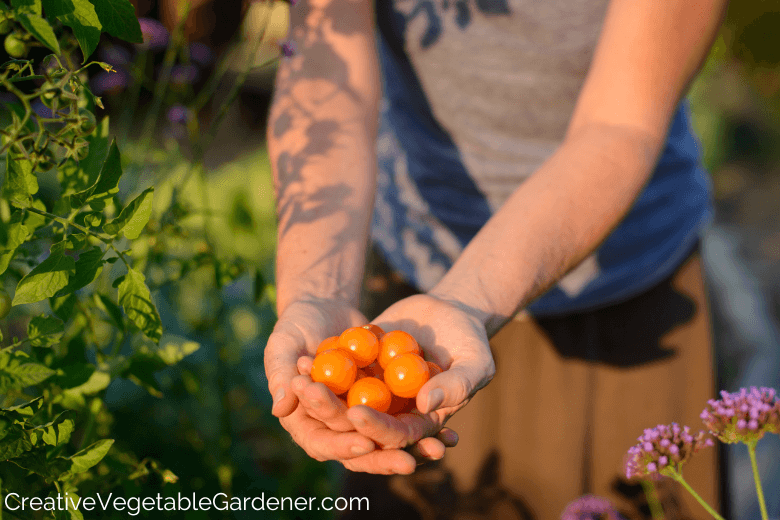
What Types of Tomatoes Need To Be Caged?
Whether your tomato plants are one of the mammoth varieties (indeterminate) or a more compact plant (determinate) you’’ need to use cages for most varieties of tomatoes. The times in my garden when I decided not to cage a tomato plant resulted in lots of regrets.
Indeterminate tomato plants continue to grow throughout the entire season and set fruit on the new growth right up until the plants are killed by frost. My indeterminate tomatoes often grow up to 10 feet tall! You definitely need to cage these varieties, no question about it.
To help control some of this wild growth, I spend some time early in the season pruning indeterminate tomatoes.
Determinate tomatoes include the bush varieties, which are more compact than the taller (indeterminate) plants, but produce a lot of fruit on shorter stems that ripen in a short window of time. This means that there’s a lot of opportunity for the fruit becoming too heavy for the stems to bear. Then your plants are likely to sag or possibly even break.
I have had years when I was too lazy to cage these tomatoes and I had a lot of breakage and rotting. That was a mistake!
When you are selecting your tomato plants in the spring, make sure that you’re careful to select varieties that are best for your garden. In this article I share the best tomato varieties.
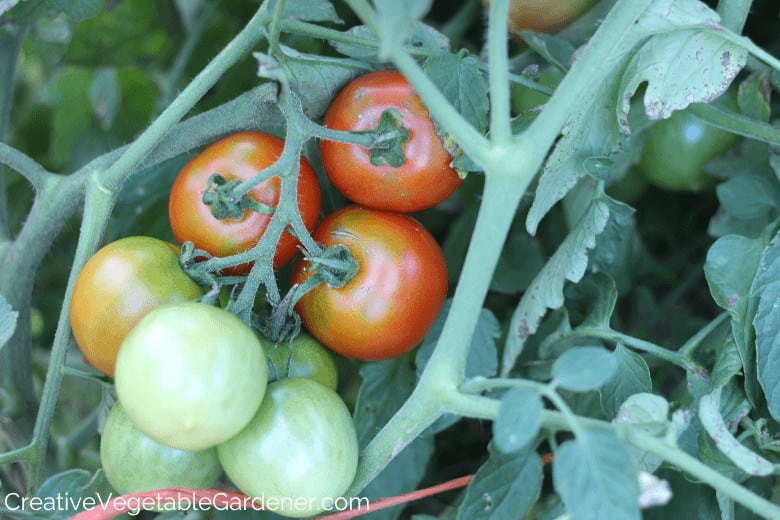
How To Select Tomato Cages
Consider carefully before you purchase your tomato cages. Do not choose undersized, flimsy cages that can’t support your beloved plants. Before you buy cages, remember how big your plants will grow by mid-season.
If you have indeterminate varieties, you’ll need to have cages that are at least six feet tall. Even if you’re growing the bush-type tomatoes, select cages that are at least four feet tall.
Remember that your plants will sprawl, too, and buy cages that are at least 14 inches in diameter.
You also want cages that are sturdy enough to withstand the weight of all of that luscious fruit. If it’s too expensive to buy high-quality cages, you can make your own using concrete reinforcing wire. Learn more about DIY tomato cages.
Once you’ve decided on the size that you need, you then have to decide what specific type of tomato cage works best for you. Below, you’ll find a description of some of the most common types. I’ve also included some of the pros and cons of each and some tips on how to use them.
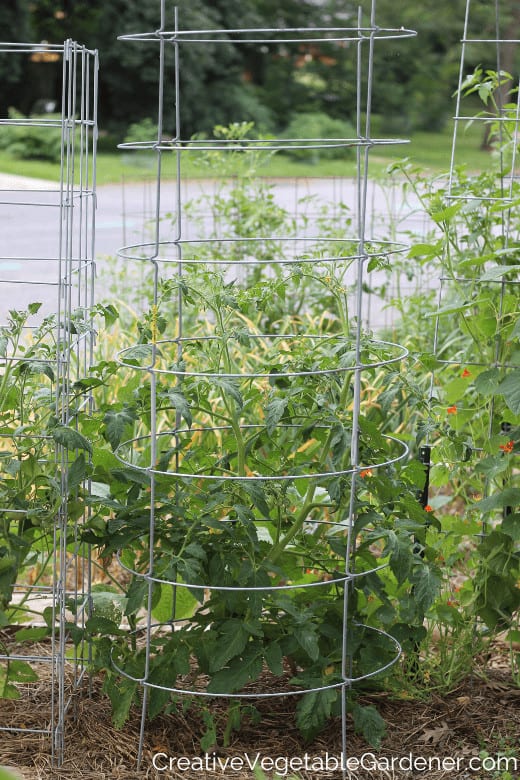
An example of a round tomato cage.
Types Of Tomato Cages And How To Use Them
Tomato cages often come in different shapes, including:
Ring-style, or circular cages.
Pros: These circular cages have the advantage of being wide, which allows the plant to spread out a bit more, providing more air circulation, which could help cut down on disease.
Cons: Depending on which type of cage you buy, they may not provide the support that very large plants need.
Can take up a lot of room in storage unless they are collapsible.
Recommended: The least expensive option is to make your own DIY tomato cage, just like I do!
Texas Tomato Cages. Read about the pros and cons of this brand at the bottom of my DIY tomato cage article.
Square or rectangular style cages
Pros: These cages often fold up for easy storage, so they’ll take up less space in your shed over the winter.
Cons: Usually aren’t necessary for more compact plants and may be cumbersome in small gardens.
Recommended: Gardener’s Supply Tomato Cage. I have a similar tomato cage as this, but not from the same company. Unfortunately, they’re only 53″ when installed. The panels come apart, so you can lay them flat in storage and you can order them in green or red, which is fun!
Triangular Cages
Pros: My personal favorite for smaller varieties of tomatoes. The triangular shape allows plenty of room for the plant to spread and produce fruit. It is also easy to center them directly over the plant. I find them very convenient to use because they’re not cumbersome, and they’re easy to center.
Most models also fold for easy and compact storage in winter.
Cons: Depending on which kind you purchase, they might not be sturdy enough for very large tomato plants.
Recommended: I was sent the Vine Spine Trellis System by Better Bilt many years back. I didn’t like them for my vining plants, but I do love them for making triangular tomato cages. Made in the Midwest.
Cattle Panel Trellis
Okay, this technically isn’t a cage, but more of a trellis. But, I still had to share because I use them in my own garden.
Pros: Great for growing super tall plants like cherry tomatoes. Easy and fun to pick because you can stand under the trellis for harvesting. Easy and inexpensive to build.
Cons: Not practical if you grow a large number of tomato plants.
Recommended: I LOVE using cattle panel trellises in my garden!
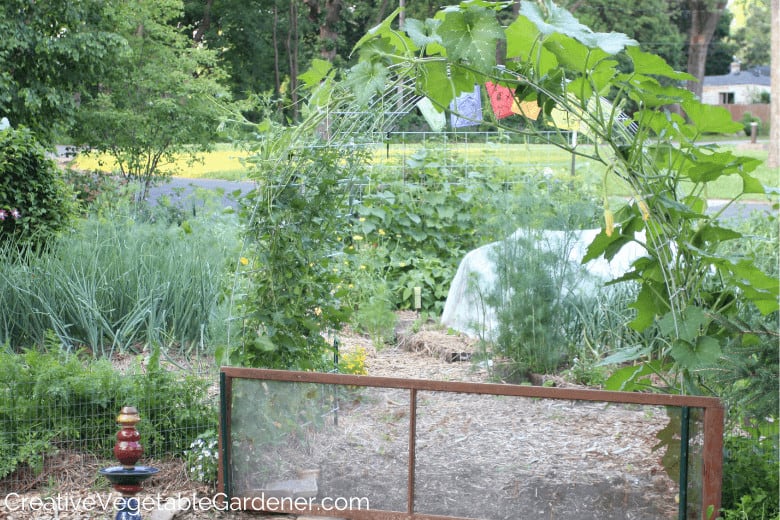
A cattle panel trellis at the entrance of my garden with Sun Gold tomatoes growing up the left side.
How To Use Tomato Cages and Care for the Plants
Some novice gardeners don’t install the cages correctly, and so the cages collapse onto the ground. It’s very, very frustrating to come outside in the morning after a heavy rainstorm to find your cages have fallen over, taking the plants with them. Trust me, I know.
To install your cage properly, center it directly over the plant. Then, press down firmly until the cage stands securely upright. (Hint-This is very important, particularly if you live in a wet climate. Too much rain softens the soil and can destabilize the cage if it’s not pressed firmly into the ground.)
If you live in a high wind area, you may want to provide extra support by pouding in a t-posts between every two cages and securing them to the post.
Then, pull the young leaves gently through the cage so that they rest on the cage wires. Some gardeners prefer to tie the stems to the cage to start to train them to climb up, but be careful that you don’t tie them too tightly!
Spread a thick layer of vegetable garden mulch around the plants right after planting and installing the cages. Mulch retains soil moisture and helps cut down on disease.
Throughout the season, pull dead leaves off of the tomato plant and pick them up off of the ground to prevent diseases from spreading. Learn more about ways to prevent tomato plant disease.
In general, tomatoes need about an inch of water per week, so water them if it doesn’t rain. You can fertilize them when planting and once during the season if necessary with an organic garden fertilizer.

Happy Harvesting!
If you follow these tips, you should have an abundant supply of succulent tomatoes all season long. They’re delectable in salads and stupendous on sandwiches. What’s better than a pasta sauce or a bowl of gazpacho made from fresh home-grown tomatoes?
With all of your success, you may end up with more tomatoes than you can use right away, and next winter, you’ll be craving the rich tomato taste. Of course, you could can your leftover tomatoes, but that’s a lot of work. There are easier ways to do it.
Read more about a super quick hack for preserving tomatoes.
Now, go set out those plants, cage them, and get ready for many weeks of happy harvesting!
SHARE IT ON PINTEREST

